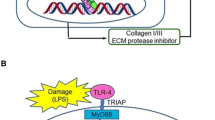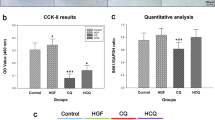Abstract
Coumaric acid is a phenolic compound found in medicinal plants. Its use has been reported in the treatment of inflammatory diseases, prevention of alterations induced by oxidative stress, as well as acetaminophen-induced hepatotoxicity. Thus, this study evaluated coumaric acid as a potential treatment for liver fibrosis. Cell proliferation was assessed by the trypan blue exclusion technique and the cytotoxicity of coumaric acid was performed using an LDH assay. Mechanisms of cell apoptosis were evaluated by flow cytometry. The expression of genes associated with apoptosis, cell cycle control, and fibrosis was assessed by qPCR. The production of lipid droplets was quantified by oil red staining. The experiments performed showed that the treatment with coumaric acid was able to reduce cell proliferation without causing cell cytotoxicity or apoptosis. Coumaric acid was able to inhibit the expression of cyclin D1 and CDK’s (CDK2, CDK4, and CDK6), increasing p53 and p21, which could lead to cell cycle arrest. Treatment with coumaric acid was also able to revert the activated phenotype of GRX cells to their quiescent state. Thus, our results suggest that coumaric acid has a potential therapeutic effect against liver fibrosis.
Graphical abstract










Similar content being viewed by others
Availability of data and materials
When requested, the authors provided the data and materials used for the development of the manuscript.
Change history
30 January 2023
A Correction to this paper has been published: https://doi.org/10.1007/s00210-023-02408-6
Abbreviations
- α-SMA:
-
Alpha smooth muscle actin
- CA:
-
Coumaric acid
- CCND1:
-
Cyclin D1
- CDK’s:
-
Kinase-dependent cyclins
- CDKI’s:
-
Kinase-dependent cyclins inhibitors
- CIS:
-
Cisplatin
- CLA:
-
Chlorogenic acid
- CLI:
-
Chronic liver injury
- Col-1:
-
Collagen
- DMEM:
-
Dulbecco’s Modified Eagle’s Medium
- EMC:
-
Extracellular matrix
- F1:
-
Fractions 1
- F2:
-
Fractions 2
- F3:
-
Fractions 3
- FBS:
-
Fetal bovine serum
- GA:
-
Gallic acid
- GFAP:
-
Glial fibrillary acidic protein
- GRX:
-
Hepatic stellate cell line
- HA:
-
Hydroxybenzoic acid
- HF:
-
Hepatic fibrosis
- HPLC:
-
High-performance liquid chromatography
- HSCs:
-
Hepatic stellate cells
- LDH:
-
Lactate dehydrogenase
- MP:
-
Moquiniastrum polymorphum subsp. Polymorphum
- NAC:
-
N-acetylcysteine
- PPAR-γ:
-
Proliferation-activated gamma receptor
- ORO:
-
Oil red-O
- TE:
-
Total extract
- TGF-β:
-
Transforming growth factor beta
References
Alatas FS, Matsuura T, Pudjiadi AH et al (2020) Peroxisome proliferator-activated receptor gamma agonist attenuates liver fibrosis by several fibrogenic pathways in an animal model of cholestatic fibrosis. Pediatr Gastroenterol Hepatol Nutr 23:346. https://doi.org/10.5223/pghn.2020.23.4.346
Bassiony H, Sabet S, Salah El-Din TA et al (2014) Magnetite nanoparticles inhibit tumor growth and upregulate the expression of P53/P16 in Ehrlich solid carcinoma bearing mice. PLoS ONE 9:e111960. https://doi.org/10.1371/journal.pone.0111960
Basso B de S, de Mesquita FC, Dias HB et al (2019) Therapeutic effect of Baccharis anomala DC. extracts on activated hepatic stellate cells. EXCLI J 18:91–105. https://doi.org/10.17179/excli2018-1696
Besson A, Dowdy SF, Roberts JM (2008) CDK inhibitors: cell cycle regulators and beyond. Dev Cell 14:159–169. https://doi.org/10.1016/j.devcel.2008.01.013
Calzadilla P, Sapochnik D, Cosentino S et al (2011) N-acetylcysteine reduces markers of differentiation in 3T3-L1 adipocytes. Int J Mol Sci 12:6936–6951. https://doi.org/10.3390/ijms12106936
Cha H, Lee S, Lee JH, Park J-W (2018) Protective effects of p-coumaric acid against acetaminophen-induced hepatotoxicity in mice. Food Chem Toxicol 121:131–139. https://doi.org/10.1016/j.fct.2018.08.060
Cheng D, Chai J, Wang H et al (2021) Hepatic macrophages: key players in the development and progression of liver fibrosis. Liver Int 41:2279–2294. https://doi.org/10.1111/liv.14940
Darzynkiewicz Z, Bedner E, Smolewski P (2001) Flow cytometry in analysis of cell cycle and apoptosis. Semin Hematol 38:179–193. https://doi.org/10.1016/S0037-1963(01)90051-4
David N de, Mauro M de O, Gonçalves CA et al (2014) Gochnatia polymorpha ssp. floccosa: bioprospecting of an anti-inflammatory phytotherapy for use during pregnancy. J Ethnopharmacol 154:370–379. https://doi.org/10.1016/j.jep.2014.04.005
de Moraes GV, Da Silveira MA, de Oliveira PD (2019) Genus Moquiniastrum (Asteraceae): overview of chemical and bioactivity studies. Curr Bioact Compd 15:377–398. https://doi.org/10.2174/1573407214666180524094146
de Souza BB, Haute GV, Ortega-Ribera M et al (2021) Methoxyeugenol deactivates hepatic stellate cells and attenuates liver fibrosis and inflammation through a PPAR-ɣ and NF-kB mechanism. J Ethnopharmacol 280:114433. https://doi.org/10.1016/j.jep.2021.114433
Di Micco R, Krizhanovsky V, Baker D, d’Adda di Fagagna F (2021) Cellular senescence in ageing: from mechanisms to therapeutic opportunities. Nat Rev Mol Cell Biol 22:75–95. https://doi.org/10.1038/s41580-020-00314-w
Edlich F (2018) BCL-2 proteins and apoptosis: recent insights and unknowns. Biochem Biophys Res Commun 500:26–34. https://doi.org/10.1016/j.bbrc.2017.06.190
Ghatei N, Nabavi AS, Toosi MHB et al (2017) Evaluation of bax, bcl-2, p21 and p53 genes expression variations on cerebellum of BALB/c mice before and after birth under mobile phone radiation exposure. Iran J Basic Med Sci 20:1037–1043. https://doi.org/10.22038/IJBMS.2017.9273
Ginès P, Krag A, Abraldes JG et al (2021) Liver cirrhosis. Lancet 398:1359–1376. https://doi.org/10.1016/S0140-6736(21)01374-X
Guarneire GJ, Lima NM, Carli GP, et al (2021) Ethnobotanical assessment in protected area from Brazilian Atlantic Forest. Res Soc Dev 10:e15310413714. https://doi.org/10.33448/rsd-v10i4.13714
Higashi T, Friedman SL, Hoshida Y (2017) Hepatic stellate cells as key target in liver fibrosis. Adv Drug Deliv Rev 121:27–42. https://doi.org/10.1016/j.addr.2017.05.007
Khomich O, Ivanov AV, Bartosch B (2019) Metabolic hallmarks of hepatic stellate cells in liver fibrosis. Cells 9:24. https://doi.org/10.3390/cells9010024
Kim S-E, Park JW, Kim M-J et al (2018a) Accumulation of citrullinated glial fibrillary acidic protein in a mouse model of bile duct ligation-induced hepatic fibrosis. PLoS ONE 13:e0201744. https://doi.org/10.1371/journal.pone.0201744
Kim W, Lim D, Kim J (2018b) p -coumaric acid, a major active compound of Bambusae Caulis in Taeniam, suppresses cigarette smoke-induced pulmonary inflammation. Am J Chin Med 46:407–421. https://doi.org/10.1142/S0192415X18500209
Kisseleva T, Brenner D (2021) Molecular and cellular mechanisms of liver fibrosis and its regression. Nat Rev Gastroenterol Hepatol 18:151–166. https://doi.org/10.1038/s41575-020-00372-7
Koopman R, Schaart G, Hesselink MK (2001) Optimisation of oil red O staining permits combination with immunofluorescence and automated quantification of lipids. Histochem Cell Biol 116:63–68. https://doi.org/10.1007/s004180100297
Kumar P, Nagarajan A, Uchil PD (2018) Analysis of cell viability by the lactate dehydrogenase assay. Cold Spring Harb Protoc 2018:pdb.prot095497. https://doi.org/10.1101/pdb.prot095497
Lee M, Rho HS, Choi K (2019) Anti-inflammatory effects of a P-coumaric acid and kojic acid derivative in LPS-stimulated RAW264.7 macrophage cells. Biotechnol Bioprocess Eng 24:653–657. https://doi.org/10.1007/s12257-018-0492-1
Li C, Lee S, Lai W et al (2021) Cell cycle arrest and apoptosis induction by Juniperus communis extract in esophageal squamous cell carcinoma through activation of p53-induced apoptosis pathway. Food Sci Nutr 9:1088–1098. https://doi.org/10.1002/fsn3.2084
Limeiras SMA, Oliveira BC, Pessatto LR et al (2017) Effects of Moquiniastrum polymorphum ssp floccosum ethnolic extract on colorectal carcinogenesis induced by 1,2-dimethylhydrazine. Genet Mol Res 16. https://doi.org/10.4238/gmr16019518
Liu X, Xu J, Rosenthal S et al (2020) Identification of lineage-specific transcription factors that prevent activation of hepatic stellate cells and promote fibrosis resolution. Gastroenterology 158:1728-1744.e14. https://doi.org/10.1053/j.gastro.2020.01.027
Martins GG, Lívero FA dos R, Stolf AM et al (2015) Sesquiterpene lactones of Moquiniastrum polymorphum subsp. floccosum have antineoplastic effects in Walker-256 tumor-bearing rats. Chem Biol Interact 228:46–56. https://doi.org/10.1016/j.cbi.2015.01.018
Mendes Ouri FGDO, Caruso PB, Da Silva GV et al (2018) Antifibrotic effect of Pluchea sagitallis (Lam.) cabrera aqueous extract in grx cell lineage. Int J Phytomedicine 10:30. https://doi.org/10.5138/09750185.1832
Piornedo R dos R, de Souza P, Stefanello MÉA et al (2011) Anti-inflammatory activity of extracts and 11,13-dihydrozaluzanin C from Gochnatia polymorpha ssp. floccosa trunk bark in mice. J Ethnopharmacol 133:1077–1084. https://doi.org/10.1016/j.jep.2010.11.040
Plano SA, Baidanoff FM, Trebucq LL et al (2021) Redox and antioxidant modulation of circadian rhythms: effects of nitroxyl, N-acetylcysteine and glutathione. Molecules 26. https://doi.org/10.3390/molecules26092514
Rahman MM, Shahab NB, Miah P et al (2021) Polyphenol-rich leaf of Aphanamixis polystachya averts liver inflammation, fibrogenesis and oxidative stress in ovariectomized Long-Evans rats. Biomed Pharmacother 138:111530. https://doi.org/10.1016/j.biopha.2021.111530
Roychoudhury S, Sinha B, Choudhury BP et al (2021) Scavenging properties of plant-derived natural biomolecule para-coumaric acid in the prevention of oxidative stress-induced diseases. Antioxidants 10:1205. https://doi.org/10.3390/antiox10081205
Stepanenko AA, Sosnovtseva AO, Valikhov MP et al (2022) Superior infectivity of the fiber chimeric oncolytic adenoviruses Ad5/35 and Ad5/3 over Ad5-delta-24-RGD in primary glioma cultures. Mol Ther Oncolytics 24:230–248. https://doi.org/10.1016/j.omto.2021.12.013
Strober W (2001) Trypan blue exclusion test of cell viability. In: Current Protocols in Immunology. John Wiley & Sons, Inc., Hoboken, NJ, USA
Teratake Y, Kuga C, Hasegawa Y et al (2016) Transcriptional repression of p27 is essential for murine embryonic development. Sci Rep 6:26244. https://doi.org/10.1038/srep26244
Troeger JS, Mederacke I, Gwak G et al (2012) Deactivation of hepatic stellate cells during liver fibrosis resolution in mice. Gastroenterology 143:1073-1083.e22. https://doi.org/10.1053/j.gastro.2012.06.036
Tsochatzis EA, Bosch J, Burroughs AK (2014) Liver cirrhosis. Lancet 383:1749–1761. https://doi.org/10.1016/S0140-6736(14)60121-5
Weiskirchen R, Tacke F (2016) Liver fibrosis: from pathogenesis to novel therapies. Dig Dis 34:410–422. https://doi.org/10.1159/000444556
Zhang C-Y, Yuan W-G, He P et al (2016) Liver fibrosis and hepatic stellate cells: Etiology, pathological hallmarks and therapeutic targets. World J Gastroenterol 22:10512. https://doi.org/10.3748/wjg.v22.i48.10512
Zhang D, Zhuang R, Guo Z et al (2018) Desmin- and vimentin-mediated hepatic stellate cell-targeting radiotracer 99m Tc-GlcNAc-PEI for liver fibrosis imaging with SPECT. Theranostics 8:1340–1349. https://doi.org/10.7150/thno.22806
Funding
This study was funded by the Coordenação de Aperfeiçoamento de Pessoal de Nível Superior (CAPES/Brazil; Financial Code 001), through a fellowship for the first author, and by National Council for Scientific and Technological Development (CNPq/Brazil) (Grant#311424/2018–0). License for Research on Brazil’s Biodiversity, CNPq#010852/2014–0 and Sistema Nacional de Gestão do Patrimônio Genético e do Conhecimento Tradicional Associado–SISGEN# ABAD620.
Author information
Authors and Affiliations
Contributions
JOR and ERS conceived and planned this project. MSB performed all experiments. BPC, GHV, and DM helped in phenotypic reversal and gene expression experiments. KHA performed the flow cytometry experiments. RMS helped during the gene expression experiments as well as in writing the manuscript. MSB analyzed the data and wrote the manuscript with review and contributions from JOR, ERS, and MFD. All authors approved the final manuscript.
Corresponding author
Ethics declarations
Ethical approval
Not applicable.
Competing interests
The authors declare no competing interests.
Additional information
Publisher's note
Springer Nature remains neutral with regard to jurisdictional claims in published maps and institutional affiliations.
The original version of this article was revised. The name of the sixth author is now corrected.
Rights and permissions
Springer Nature or its licensor (e.g. a society or other partner) holds exclusive rights to this article under a publishing agreement with the author(s) or other rightsholder(s); author self-archiving of the accepted manuscript version of this article is solely governed by the terms of such publishing agreement and applicable law.
About this article
Cite this article
Bastos, M.S., Saalfeld, R.M., Costa, B.P. et al. Coumaric acid from M. polymorphum extracts reverses the activated state of hepatic stellate cells (GRX) and inhibits their proliferation by decreasing the p53/p21 pathway. Naunyn-Schmiedeberg's Arch Pharmacol 396, 925–937 (2023). https://doi.org/10.1007/s00210-022-02361-w
Received:
Accepted:
Published:
Issue Date:
DOI: https://doi.org/10.1007/s00210-022-02361-w




